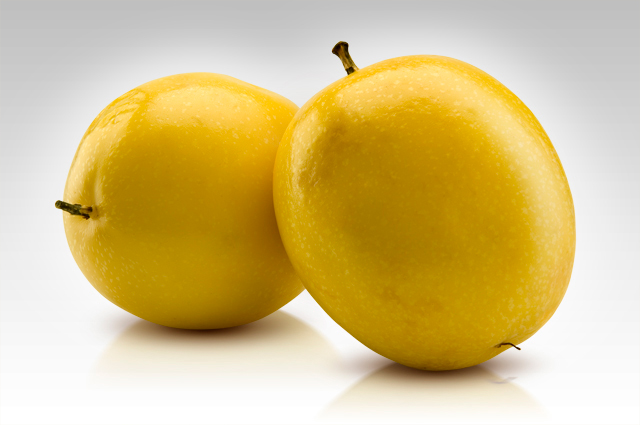Synonym: Passiflora edulis var. flavicarpa
Common Names: Liliko'i, Lilikoi, Yellow Passionfruit, Yellow skinned Passion Fruit
Plant Characteristics
Duration: 3-7 years.
Growth Habit: Climbing Vine
Hawaii Native Status: Introduced. This naturalized ornamental garden plant and food plant is native to the Amazon region in Brazil.
Flower Color: White to tinged purple
Flowering Season: Spring, Summer, Fall
Height: To 20 feet (6 m) long
Passiflora Edulis Var. Flavicarpa is another closely related plant to the Passiflora Edulis. The yellow passion fruit is known to be slightly bigger in size than the purple passionfruit, and yields a large, slightly oval fruit. The yellow passionfruit is also sweeter in
taste when compared to the passionfruit, and often yields more fruit than the purple passionfruit.

The Yellow Passion Fruit is one of several species of the genus -all woody, perennial vines native to the tropical Americas- that produce edible fruits. It is a fast-growing vine and is also suitable for ornamental screening purposes. The alternate curly leaves are deeply 3-lobed, and the vines climb readily by means of long tendrils in each leaf axil.
The yellow passion fruit is an excellent home fruit and offers great possibilities for commercialization in the American Tropics.
 The Yellow Passion Fruit is also resistant to a wilt disease, probably caused by a species of Fusarium, which kills the plants.
The Yellow Passion Fruit is also resistant to a wilt disease, probably caused by a species of Fusarium, which kills the plants.Germination Info:
It is recommended to pretreat Passiflora seeds before planting. They contain a hard seed coat and are very slow to sprout. There are various pretreatment methods, but the simplest is to soak the seeds for 24-48 hours in warm to the touch water, just prior to planting. Optionally, seeds can be lightly scarified with sand paper to provide some permeation on the seed coat.
Once pretreated, plant seeds 1/2-1" deep in moist, sterile soil. Keep soil temperature consistent at 70-85F, with some day/variation in this range. Cool soils will significantly delay seed germination time if not inhibit germination altogether. Standard room temperature can be too cool for proper germination.
The seeds of the yellow passionfruit are however, known to be easy to germinate, though it only germinates when temperatures are ranging from 20-26°C.
Flowering Habit:
Flowering occurs from April-November but may occasionally continue year-round if conditions are right. Individual flowers bloom for just 12-24 hours before closing.

Unlike the purple passionfruit, this variety can self pollinate and will not require a second plant for pollination. 7 out of 10 yellow passionfruit flowers are usually fake flowers, meaning they appear to be just like any other flower, but with a dead ovary.
These fake flowers feature a small and yellowish Ovary and slightly smaller or deformed flowers.
3 out of 10 flowers will fruit, and can be determined by checking on the Ovary. Those that fruit usually have bigger ovaries with a green hinge.
Fake or real flowers can be already determined even before the flower fully opens.
Location: Plant passion fruit vines in full sun except in very hot areas where partial shade is preferable. The vine can be rather rampant, so it is important to plant it next to a chain link fence or install a strong trellis before planting. The plants can also be trained into an attractive arbor.
 Soil: Passion fruit vines grow on many soil types but light to heavy sandy loams with a pH of 6.5 to 7.5 are the most suitable. Excellent drainage is absolutely necessary. Also, the soil should be rich in organic matter and low in salts. If the soil is too acid, lime must be applied. Because the vines are shallow-rooted, they will benefit from a thick layer of organic mulch.
Soil: Passion fruit vines grow on many soil types but light to heavy sandy loams with a pH of 6.5 to 7.5 are the most suitable. Excellent drainage is absolutely necessary. Also, the soil should be rich in organic matter and low in salts. If the soil is too acid, lime must be applied. Because the vines are shallow-rooted, they will benefit from a thick layer of organic mulch.Irrigation: Regular watering will keep a vine flowering and fruiting almost continuously. Water requirement is high when fruits are approaching maturity. If the soil is too dry, fruits may shrivel and fall prematurely. Fruits may also shrivel and never ripen in color in cold temperatures, mainly below 10°C, with occasional night time temperatures of 3°C.
Irrigation isn't needed when it is grown in a tropical to subtropical country which receives a lot of rain.
Fertilization: Passion fruit vines are vigorous growers and require regular fertilizing. A good choice is 10-5-20 NPK applied at the rate of 3 pounds per plant 4 times a year. Too much nitrogen results in vigorous foliage growth at the expense of flowering. Passion fruit vines should always be watched for deficiencies, particularly in potassium and calcium, and of less importance, magnesium. Plants that have been damaged by frost should receive a generous fertilizing after the weather has warmed
Pruning: Pruning is necessary to keep the vines within bounds, to make harvest easier and to keep the plants productive by maintaining vigorous growth. In warm winter climates prune immediately after harvest. In areas with cool winters prune in early spring. As a a general rule remove all weak growth and cut back vigorous growth by at least one third. In very hot climates allow a thick canopy of foliage to grow around the fruit to prevent sunburn.
No comments:
Post a Comment